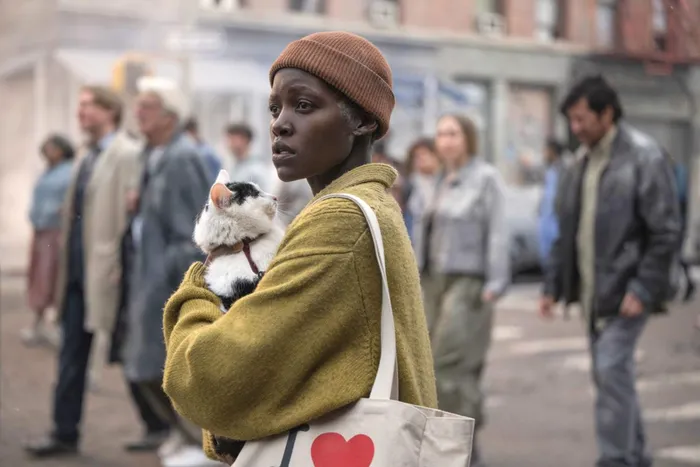
A Quiet Place
If you thought the world of A Quiet Place couldn’t get any more intense, A Quiet Place: Day One ups the ante, taking us back to the terrifying origins of humanity’s desperate fight for survival. Directed by Michael Sarnoski, this prequel dives headfirst into the chaos and confusion of the very first day the alien creatures—those now-familiar, blind predators with hypersensitive hearing—arrive on Earth. It’s a gripping, heart-pounding experience that captures the sheer panic and helplessness of a world that has suddenly fallen into deadly silence.
Day One expands the universe of the A Quiet Place franchise, offering a fresh perspective on the horrors that unfolded in those initial, devastating hours. Unlike the more intimate, isolated struggle of the Abbott family in the first two films, this prequel widens the lens, showcasing the scale of the disaster as entire cities are plunged into chaos. It’s a fast-paced, edge-of-your-seat thriller that masterfully balances the suspense of the unknown with the gut-wrenching realization of what’s to come.
Lupita Nyong’o leads a stellar ensemble cast, delivering a performance that’s as powerful as it is relatable. As the protagonist, Nyong’o portrays a woman who, like everyone else, is caught completely off guard by the sudden invasion. Her character, Evelyn, is a schoolteacher in New York City, just going about her normal day when everything falls apart. Nyong’o brings a raw, emotional depth to the role, capturing the terror, determination, and heartbreak of a person suddenly thrust into a nightmare. Her journey from a place of disbelief to one of grim resolve mirrors the audience’s own shock and horror, grounding the film’s more fantastical elements in real human emotion.
The film wastes no time getting to the action. The opening scenes are a masterclass in tension-building, depicting the calm before the storm with eerie normalcy—children playing, people going about their daily routines, and the city bustling with life. But when the first sign of the creatures’ arrival hits—subtle at first, then unmistakably catastrophic—the film shifts into high gear. The suddenness of the attack is jarring, perfectly capturing the fear and confusion that would naturally accompany such an unprecedented event.
The creatures themselves are as terrifying as ever, if not more so, given the unfamiliarity and lack of understanding among the humans who encounter them. Their brutal efficiency in hunting by sound is depicted with chilling clarity, and the sense of danger is palpable in every scene. The film does a fantastic job of recreating the eerie silence that made the first A Quiet Place so unique, with sound—or the lack thereof—playing a critical role in the storytelling. The tension is ramped up as characters quickly realize that even the slightest noise could mean instant death.
Visually, A Quiet Place: Day One is both stunning and haunting. The urban setting offers a stark contrast to the rural landscapes of the earlier films, with towering skyscrapers and crowded streets becoming a claustrophobic deathtrap once the creatures descend. The cinematography by Polly Morgan captures the chaos with a blend of wide shots that show the scale of the devastation, and close-ups that focus on the personal terror of the characters. The use of natural light and shadow enhances the sense of unease, as the film oscillates between moments of blinding daylight and dark, ominous interiors where danger lurks in every corner.
The supporting cast, including Joseph Quinn and Alex Wolff, contribute strong performances that add to the film’s emotional impact. Quinn plays a firefighter named Jack, whose instinct to save others conflicts with his need to protect his own family. His character’s arc is particularly compelling as he grapples with the impossible decisions that survival demands. Wolff, on the other hand, portrays a teenager named Max who must quickly adapt to a world where the rules have changed overnight. His portrayal of fear and confusion, mixed with bursts of bravery, is both realistic and heart-wrenching.
One of the film’s most effective elements is its pacing. Sarnoski skillfully balances moments of intense action with quieter, more reflective scenes that allow both the characters and the audience to catch their breath. The film never lingers too long in one place, maintaining a constant sense of urgency as the characters are forced to adapt to their new reality. However, in these quieter moments, Day One also explores the human side of the catastrophe—the desperation, the heartbreak, and the small acts of courage that define humanity in the face of overwhelming odds.
Despite its many strengths, A Quiet Place: Day One does face the challenge of living up to its predecessors. While the film does an excellent job of expanding the lore and delivering high-octane thrills, some may find that it lacks the intimate, character-driven focus that made the first film such a standout. The shift to a broader perspective means that while we get a better understanding of the world at large, we lose some of the personal, gut-wrenching tension that came from following a single family’s struggle for survival.
Nevertheless, A Quiet Place: Day One is a worthy addition to the franchise, offering a terrifying and exhilarating look at the dawn of a new, deadly world. It’s a film that keeps you on the edge of your seat from start to finish, with performances that resonate and a story that adds depth to the universe we’ve come to know. For fans of the series, this prequel is a must-see—just be prepared to watch through your fingers, because the tension doesn’t let up for a second.

